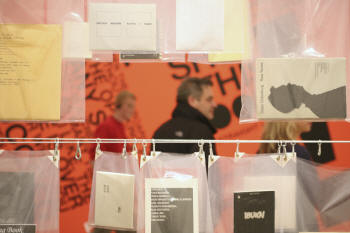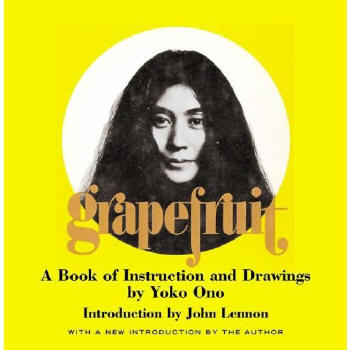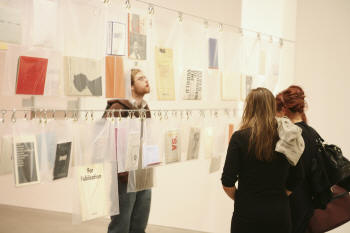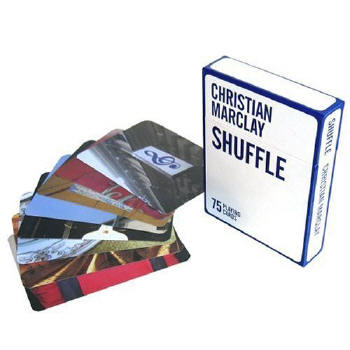|
On Arnolfini,
artists' books and buy nothing day
Nigel Ayers
 It's
Saturday, 29th November 2008. I'm in Bristol. I'm in the lower gallery
space at the Arnolfini and suspended on steel wires are a number of
plastic sleeves each containing a book. These books are all titles
authored by artists, the earliest of which dates back to 1963. They
range from small edition, hand made or home-computer-printed books
produced for gallery exhibitions, to editions by celebrity artists such
as the 2000 Simon and Schuster edition of Grapefruit by Yoko Ono and the
Aperture Foundation 2007 edition of photographic cards Shuffle by
Christian Marclay. To the side of this display is a plain formica-topped
table on which stand two computer monitors and three table-top lecterns. It's
Saturday, 29th November 2008. I'm in Bristol. I'm in the lower gallery
space at the Arnolfini and suspended on steel wires are a number of
plastic sleeves each containing a book. These books are all titles
authored by artists, the earliest of which dates back to 1963. They
range from small edition, hand made or home-computer-printed books
produced for gallery exhibitions, to editions by celebrity artists such
as the 2000 Simon and Schuster edition of Grapefruit by Yoko Ono and the
Aperture Foundation 2007 edition of photographic cards Shuffle by
Christian Marclay. To the side of this display is a plain formica-topped
table on which stand two computer monitors and three table-top lecterns.
There are cards on the table with the following text:
|
RULES
FOR VISITORS WISHING TO HANDLE ARTISTS' BOOKS
1. Only one book per person may be requested at a time
2. To avoid the transfer of grease and dirt to collection items,
please use the gloves provided. Hand wipes and paper towels are
also available on request.
3. Handle all items as little as possible. Pages must be turned
carefully. Avoid leaning on books or papers as this may damage the
binding structure or tear the paper.
4. Where appropriate, please use the book beds and snake weights
to hold pages open.
5. Books may only be viewed whilst seated at the desk. If you wish
to make notes, use pencils only.
6. Absolutely no food or drink (including water) is allowed in the
exhibition space.
|
I attempt to take a photograph of this arrangement of books, chairs,
tables and computer monitors, but I am intercepted by a young woman I
assume to be a member of gallery staff. She instructs me that it is
alright to take photographs but first I must sign a form. The form has
been printed by what looks like a photocopier process on two sides of a
sheet of white 80 gsm paper cut to A5 size with two holes punched along
one of the long sides. The printing is parallel to the long edge of the
paper and contains the following text, set in Arial font:
Copyright - Agreement Form
name
address
wish to make a copy of the following artists' work
[Please specify artist and work]
* personal use: for private study or research.
* Educational Instruction: limited to the work being copied in the
course of instruction or preparation for instruction.
I understand that any use of the copy taken for purposes other
than ticked above may constitute an infringement of copyright for
which the copyright owner could take action against me.
There are spaces where I sign and date this agreement. This is
countersigned and dated by the young woman "(on behalf of
Arnolfini)".
I turn over the piece of paper to read the obverse.
Copyright
Recording, photography and copying of any artistic performance,
work or film is not permitted under the terms of Copyright,
Designs and Patents Act 1988 (and subsequent amendments).
Should you wish to make copies or such work and/or distribute,
rent or loan, adapt, perform or broadcast you should always seek
the permission of the copyright owner or obtain an appropriate
licence.
Personal Use
Arnolfini has reached an agreement with the artist(s) for
permission for visitors to take photographs of their work for
personal use only. You are requested to complete a copyright
agreement form fully for authorisation before you take any
photographs.
Educational Use
Arnolfini has reached an agreement with the artist(s) for
permission for educational organisations, groups and schools
visiting Arnolfini to make photographic/drawing/film copies of
their work for educational instruction purposes only. The group
leader is requested on behalf of their organisation/school to
complete a copyright agreement form fully for authorisation before
your visit/workshop/tour begins.
Press and Publicity Use
Arnolfini will have reached agreement with all artists for
permission to use copies/images of their work for press and
publicity purposes. Requests for such material must be made to
Arnolfini's Marketing Department, who will require you to complete
a copyright agreement form for authorisation before any copies of
artists work are taken or made.
Should you subsequently use any copy of work taken, for a purpose
not authorised, or which constitutes an infringement of copyright,
you could be liable to prosecution by the copyright owner.,
Unauthorised recording, photography and copying of any artistic
performance, work or film within Arnolfini is not permitted. |
 I
notice that throughout this document the Arnolfini gallery, is referred
to as "Arnolfini" and not "the Arnolfini" as it was known formerly. And
as I notice that, I hear the implant in my brain softly whisper: "In the
"Arnolfini-rather-than-the-Arnolfini" affectation the art gallery
is reinvented. I
notice that throughout this document the Arnolfini gallery, is referred
to as "Arnolfini" and not "the Arnolfini" as it was known formerly. And
as I notice that, I hear the implant in my brain softly whisper: "In the
"Arnolfini-rather-than-the-Arnolfini" affectation the art gallery
is reinvented.
"The Arnolfini" can be read as an
association of human beings grouped around a physical space. Without the
"the" this association becomes a projection of a human essences and
physical space that have been alienated and abstracted. It is not
Arnolfini and his wife, it is a form of artificial life: "Arnolfini",
the corporation!
Returning to the table, I pick up another piece of paper, this time an
A3 sheet of paper folded down to an A5 size, the Exhibition Guide. This
informs me that: "this exhibition explores a specific
tendency in artists' bookworks to generate an energetic series of events
and activity. Focusing on books that either offer sets of instructions
to the reader, or are themselves derived from instructions, the books
look to unsettle the usual distinctions between writers and readers,
artists and audiences, and act as prompts to their readers to go beyond
the conventions of reading. Much of this work has roots in the practices
of the 1960's Fluxus artists."
On one side of this sheet is a BIBLIOGRAPHY, a list of 72 publications
which refers to the books in the plastic sleeves. I recognise another
rock star on the list, Bill Drummond, others on the the list I associate
with "happenings", pop art, performance art, and relational art. Allan
Kaprow, Jan Dibbets, Clause Oldenberg, Lawrence Wiener, Wolf Vostell,
Victor Burgin, Liam Gillick, Fiona Banner, all the usual suspects. Most
of the authors are represented in this collection by one to four books,
the exception in this list is Steven Paige, who is credited with twelve
books. Steven Paige's name also attracts my attention as I am aware that
he lives in West Cornwall.
 "Library"
by Steven Paige comprises a small bookshelf fixed to the gallery wall on
which are displayed a few books in plain white, black lettered
dust-jackets. There is a level of ambiguity in the display, are these
real books or are they false books for display purposes only? I refer
back to the Exhibition Guide: "You may join The
Library by filling in the form provided and handing it in to a steward,
including details of books you would like to see in the library
collection. Every week the artist will update the bibliographies, and
new books will be added to The Library. if you decide to become a
member, you are welcome to return to the exhibition to see your books
displayed on the shelves". "Library"
by Steven Paige comprises a small bookshelf fixed to the gallery wall on
which are displayed a few books in plain white, black lettered
dust-jackets. There is a level of ambiguity in the display, are these
real books or are they false books for display purposes only? I refer
back to the Exhibition Guide: "You may join The
Library by filling in the form provided and handing it in to a steward,
including details of books you would like to see in the library
collection. Every week the artist will update the bibliographies, and
new books will be added to The Library. if you decide to become a
member, you are welcome to return to the exhibition to see your books
displayed on the shelves".
Its a nice piece, but as I fold the paper, the implant in my brain
whispers "I think my local library has a better idea, there you can
actually borrow the books, and if you want you can read them...."
Then the softly spoken implant in my brain is interrupted by a burst of
static, through which I can make out the ring-modulated words: "That's
the 2000 edition of Yoko Ono's Grapefruit they are handling with white
gloves there it is currently available at Amazon for £9.89, Christian
Marclay's Shuffle retails for £19.95. While many of the other books on
display are rare and reach high prices among collectors, surely the
value of dematerialised art is the use-value of the actions rather than
exchange-value of the books as objects? If the use-value as an energetic
series of events and activity is important why not supply cheap digital
reproductions of the original texts, which can be handled while you
engage in an energetic series of events, without fear of damaging
precious books?"
 I
think this must be a second implant in my brain speaking. I
think this must be a second implant in my brain speaking.
And now the first implant starts up with the seditious whisper "Central
to 1960s Fluxus was the idea that its simple, inexpert, bizarre, events
were presented as possibilities for an iconoclastic insight into the
nature of reality itself. In the 1963 Fluxus New-Policy Letter No. 6
Fluxus-founder George Maciunas outlined his proposed actions against
"serious culture" for Fluxus in New York, broken down into four main
areas:
a) Pickets and demonstrations
b) Sabotage and destruction
c) Compositions
d) Sale of Fluxus publications."
And now the second implant is barking out all Dalek-like: "The rigidly
controlled way this exhibition has been presented highlights the current
fashion for a depoliticised, corporate aesthetic. The audience is put
through a series of pointless, bureaucratic events. The utopian current
is contained by repressive rituals and pointless activity!! "
And now the first implant, with a hypnotic phrasing like you might get
on a mind-programming CD, says: "Or is the whole show an elaborate hoax
set up to take the piss out of art-nerds? Never mind, today is 29th
November! It is Buy Nothing Day! Buy Nothing Day is a simple idea, which
challenges consumer culture by asking us to switch off from shopping for
a day. Some suggestions for an energetic series of events and activity
to do on Buy Nothing Day can be found on
http://www.buynothingday.co.uk/?page_id=5"
The Cover of a Book is the Beginning of a Journey
22 November 2008 - 18 January 2009
Arnolfini, 16 Narrow Quay, Bristol, BS1 4QA
Nigel Ayers
http://www.nigelayers.com
Photos: Carl Newland
|




